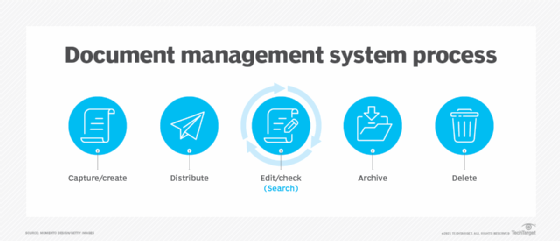enterprise document management (EDM) (original) (raw)
Enterprise document management (EDM) is a strategy for overseeing an organization's paper and electronic documents so they can be easily retrieved in the event of a compliance audit or subpoena. The term originally referred to electronic documents that were created on a computer or paper documents that were scanned into a digital format. The meaning has broadened to include email, images, internal-facing documents -- such as company memos -- and external documents -- such as marketing or sales content.
In the context of regulatory compliance, enterprise document management must address the following:
- How long the business should retain documents.
- Where the business should store documents.
- How to trace changes to the documents.
- How to recover documents if a disaster occurs.
EDM also stands for electronic document management, engineering data management and electrical discharge machine.
How does enterprise document management work?
An enterprise document management strategy helps provide an organization with a clear plan for its document management processes. An organization can use an EDM strategy to decide how to receive, process, review, store, retrieve and dispose of documents, as well as when it should complete each step. The EDM strategy determines how the business should adjust the process to increase efficiency.

The document management process can help organizations determine how to receive, process, review, store, retrieve and dispose of documents.
An organization can use a document management system (DMS) to create a single view of all an enterprise's documents and provide workflow tools to monitor and control modifications. A DMS enables businesses to capture a document by either scanning the physical document or downloading the digital version.
After scanning or downloading the document, the user can tag and index the document with keywords and metadata to enable other users to quickly find them by searching. The DMS organizes and places the document into a folder that employees who have permission can access. These systems also help ensure compliance by placing permission restrictions on certain documents and providing extra security.
Why is enterprise document management important?
Organizations have vast amounts of content in both paper and digital formats which users can store in public or private networks, shared drives, email or filing cabinets. Storing physical files comes with risks, however.
An enterprise document management system (EDMS) reduces the need -- and associated expense -- of physical storage space. Unforeseen circumstances, such as a fire or flood, could potentially damage or destroy physical files. EDMSes typically include a data backup and disaster recovery plan, which provides businesses with a digital backup.
Organizations with files in multiple locations might struggle to find the information they need -- which is crucial for meeting legal requirements. EDMSes enable greater organization because all files are in one central location and users can easily find files using full-text search. By having all files in one digital location, users can access the files anywhere at any time.
EDMSes can integrate with other applications including content management systems, Microsoft Office and Salesforce. Because users generally use other tools within their workflow, it's important for an organization's EDMS to be able to integrate with other applications easily.
There are many moving parts within a company, and an EDMS can help decrease bottlenecks and maintain an organized workflow. Version control and security within the EDMS make it easy for users to see who has access to certain documents and what changes other users made, which also ensures an organized workflow.
Differences between EDM and ECM
Although enterprise document management and enterprise content management (ECM) might sound similar, they aren't interchangeable terms. The following highlights some of their differences:
- Businesses use an EDMS to organize paper and electronic documents and structured content. ECM systems let organizations capture, manage, store, preserve and deliver many additional types of content.
- ECM systems can organize paper and digital documents, but they can also handle other unstructured content, such as audio and video files, social media, web pages, contracts, purchase orders, invoices and receipts.
- EDM software is designed to control the lifecycle of documents and ensure compliance. In addition to storing files, it focuses on the tools and processes that businesses use throughout the lifecycle of content.
- EDM is a subcategory of ECM, and as a result, an ECMS might not function properly without an EDM system in place.
Types of document management systems
Document management systems are available as on-premises and cloud-based software.
An on-premises DMS lets businesses use their own storage and perform their own maintenance. Organizations with an on-premises DMS are also responsible for their own security. This type of DMS doesn't rely on the internet -- if the internet connection goes down, users can still access all their documents in the DMS. However, the downside of on-premises DMSes includes the large upfront costs, plus yearly expenses for software updates. Files in an on-premises DMS don't automatically save to the cloud, so backing up frequently is important.
A cloud-based DMS is accessible to the business online. The cloud provider typically charges a monthly or an annual fee that includes maintenance and software updates. Unlike the on-premises option, a cloud-based DMS isn't as expensive and there are no high upfront costs. Users of a cloud-based DMS don't need to back up their files because they're automatically saved in the cloud. Users can access the cloud-based system wherever there's internet; however, if the internet connection fails, the user won't be able to access their files. Cloud-based DMSes depend entirely on the provider to keep the system up and running, while on-premises systems depend on the business's own IT resources.
Key features and components of an EDMS
An EDMS lets businesses scan, store and retrieve business documents, but it offers additional features, including the following:
- Document classification enables users to categorize documents with metadata fields.
- Keyword search increases the user's ability to find content within the DMS.
- Document viewing letsusers see an image of the document without having to install additional software.
- Document editing enables users to edit and create new versions of documents.
- Version control lets users see all changes that other users make to a document as well as recover older versions of documents.
- Document sharing lets users share documents with internal or external users.
- Security and audit let users control which individuals or groups can access documents and what level of access they have.
- Document workflows enable administrators to determine the workflow of documents throughout an organization.
- Collaborative tools give users a utility for collective production of documents -- on-premises or remote -- with built-in messaging and accept or reject functions to streamline change management; often, these collaborative tools facilitate real-time production.
Benefits of using a document management system
A DMS can provide organizations with the following benefits:
- Manages compliance. Compliance requirements for documents can be complex, but DMSes can reduce the risk of not meeting compliance requirements, such as HIPAA (Health Insurance Portability and Accountability Act) security and privacy guidelines. DMSes can automate certain functions, such as records retention schedules, so businesses are less likely to risk noncompliance.
- Improves document security. An organization's documents are better protected when they're in a secure common repository. DMSes require users to log into the system, which provides an extra layer of security to protect content from cyberattacks and hackers.
- Improved retrieval and search. Finding documents can be time-consuming, but DMSes can retrieve files by looking for a keyword or phrase. DMSes can also index categories within a document or folder to enable an even smoother search.
- Facilitates collaboration. DMSes enable internal collaboration, as well as external collaboration with people who have authorized access. Users can access documents from different sources from multiple locations. DMSes also offer version control, which is necessary for users to recover older versions of documents.
Disadvantages of using a document management system
There are also some challenges associated with using DMSes, including the following:
- Cost. Enterprise document management software can be costly to both purchase and implement, for small businesses, in particular. It can also be expensive to maintain, and the training costs to bring on new users often aren't trivial.
- Time-consuming. The time required to set up and maintain the EDMS can be considerable.
Examples of document management systems tools and vendors
There are many EDMSes to choose from with varying capabilities. The following is a sampling of vendors providing centralized document management systems that offer a wide range of features:
DocuWare. DocuWare is a cloud-based platform for document management and workflow automation that enables businesses to transfer their digital and paper-based documents to a unified platform. Designed for businesses that use multiple software types -- including human resources, finance and accounting -- DocuWare offers document storage, importing and form handling.
Hyland OnBase. OnBase is a cloud-based document management platform that enables organizations -- including verticals such as healthcare, finance, insurance, education and government -- to create, revise, organize, manage and distribute critical business documents. OnBase offers version control, collaboration, digital signatures and synchronization for remote users.
M-Files. M-Files provides midsize and enterprise businesses with many features to organize, digitize paper records and automate workflow processes. M-Files offers on-premises, cloud-based or hybrid systems. It integrates with Adobe Sign, which enables users to apply e-signatures to M-Files documents. M-Files also integrates with Google Workspace, Microsoft 365, Salesforce and SAP.
Revver. Formerly Rubex by eFileCabinet, this cloud-based EDMS is designed for businesses of all sizes and business verticals. It automates workflows and other repetitive document work and provides document storage capacity tools. Revver integrates with DocuSign, Microsoft Office and Salesforce.
Zoho WorkDrive. Designed for enterprises of all sizes and multiple verticals, Zoho WorkDriveoffers cloud storage that enables teams to collaborate, store, edit and manage documents. Roles-based access enables teams to share documents securely.
Although having an EDM strategy in place is important in the overall compliance audit process, organizations should also review this compliance audit preparation checklist to learn which other activities must be addressed.
This was last updated in May 2024
Continue Reading About enterprise document management (EDM)
- Records vs. document management: What's the difference?
- How to choose the right document management system
- Best enterprise content management software
- How to build a successful paperless office strategy
- Why your business needs to consider cloud-based ECM
 Top 5 free and open source ECM software
Top 5 free and open source ECM software  By: Christine Campbell
By: Christine Campbell  Document management vs. content management: How they differ
Document management vs. content management: How they differ  By: Erica Mixon
By: Erica Mixon  Slack software
Slack software  By: Rahul Awati
By: Rahul Awati  By: Karl Flinders
By: Karl Flinders